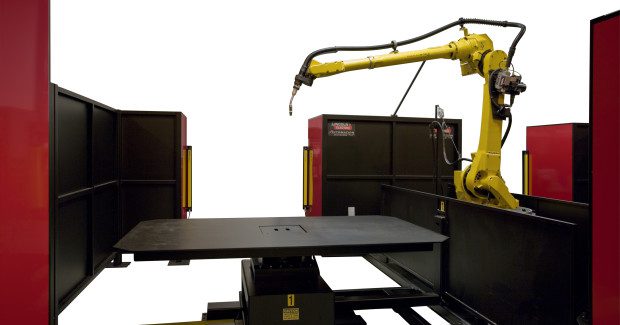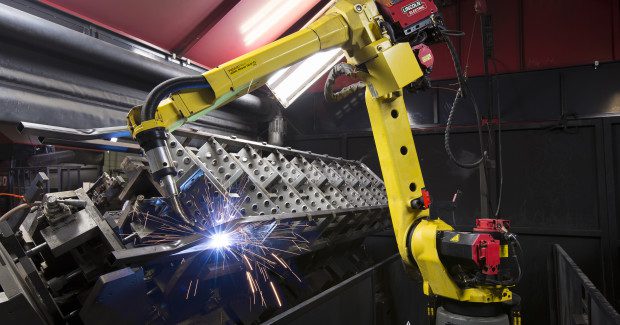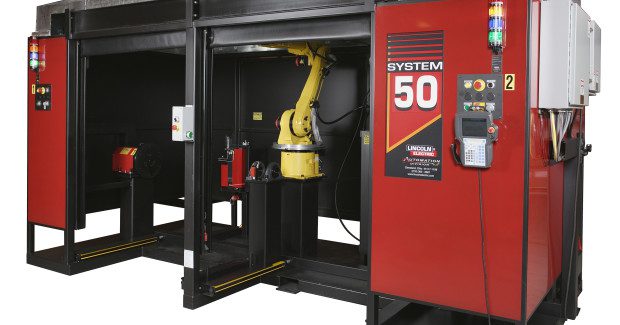Welding Robots Justified
The traditional ROI focused on robots as a direct replacement for people. But many fabricators now investing in automation with welding robots eventually hire more people too. What is going on?
Posted: March 28, 2013
A very interesting statistic to me is that fabricators that buy welding robots end up growing and then hiring more people. What? Huh? What does that mean?
This fact seems very counter-intuitive and defies the traditional logic that robots are a direct replacement for people. So how can it be that so many manufacturers that use robots eventually hire more people too? It’s simple, really. Robots are a manufacturing “enabler” that spur on real growth and fast-track production. When productivity goes up, shops find they can take on more work. More workers must be hired to cover the new business. The added labor supports the shop growth that accompanies the use of robots.
I don’t think they go over that in any particular college class, but that’s what we see happening all the time in the field. For example, let’s assume that a certain domestic shop plans to purchase a robotic welding cell that costs $140,000. How does this shop explain and justify making this investment?
The facility currently uses 5,000 man-hours to weld 5,000 parts a year, or the equivalent of one part per one man-hour. Besides the direct labor costs to pay for a welding technician, one man-hour of weld time also carries overhead and burden expenses associated with whatever that technician is welding. All of these expenses result in a standard cost of $65 per man-hour. This means that manual welding by hand costs the shop: $65 per man-hour X 5,000 man-hours per year = $325,000 per year.
Now compare this to a robot that does the welding and drastically reduces each part-to-part cycle time. Using the robotic welding cell and a known robotic part load, weld and unload cycle time, production increases to 5,000 parts in only 3,500 hours. This means that automated welding by the robot costs the shop: $65 per hour X 3,500 robot hours = $227,500 per year.
Now subtract the difference of the manual welding costs vs. the robotic welding costs: $325,000 manual costs – $227,500 automated costs = $97,500 savings per year by using a robot to weld.
Next, divide this savings per year into the upfront price to purchase the weld cell: $140,000 welding cell price / $97,500 savings using a robot = 1.4 years to pay back the initial investment in the equipment for a return on investment (ROI) of roughly 17 months. That’s not all, because the shop could potentially add more work to the remaining 1,500 available hours in the welding cell that would, in turn, reduce the payback even further.
This should help every shop see how welding robots can provide a competitive advantage and make their operation more profitable. The big question is “how much will my weld cell cost?” This is not a straight-forward question to answer, similar to asking “how much does a car cost?” The range of applications is wide and subject to the complexity of what the shop must buy to meet its demands. A baseline price of reference is that a new robotic weld cell will typically start around $70,000 and move up from there based on the customization required.
The best thing any shop can do is meet with a reputable integrator to discuss ideas and get quotes with various options. Then it comes back to the math using the method described above, making a spreadsheet and take several parts and factors into account. The most important thing here is that the numbers accurately reflect and make sense in that shop’s operation.
Skilled worker deficit is another reason companies consider using welding robots. Right now, so many business owners face this challenge: “My best welder is getting ready to retire, and I cannot find anyone to replace him.” Skilled technicians are out there, but fewer are available today than ever before. By the year 2018, a vast majority of the “baby boomer” generation will retire in the U.S., an enormous gap that is creating a deficit of skilled workers. In response, employers are turning to robots to backfill some of the jobs left by the 20 million skilled workers that are retiring.
Small and large shops alike are turning to automation and robotics as a solution because this gap is not just happening in the United States, it’s everywhere. The times, they are changing.














